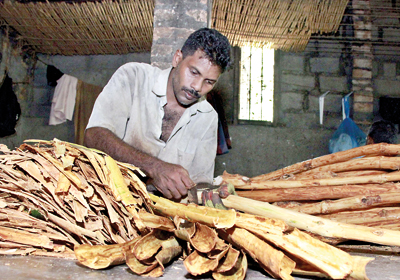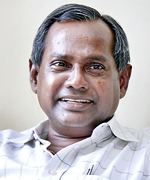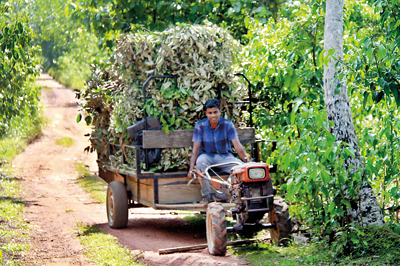Cinnamon’s spicy trail fast losing its pungency

Doing it the modern way: A.W. Manoj rubbing cinnamon
It is the pungency of our spices, notably cinnamon which launched many a ship towards this tiny island. Botanically known as Cinnamomum zeylanicum, no part of this tree goes unused. Although southern Sri Lanka today prides itself on this globally prized spice rich in medicinal properties, history has it that even present-day Cinnamon Gardens was once a thick cover of cinnamon! A lucrative commodity to the colonial masters, Ceylon Cinnamon is known to have ignited the island’s first ‘labour upheaval’ known as kurundu thalannange kerella or cinnamon peelers’ protest during the Dutch colonial times.
The intrinsic properties of our cinnamon including its aroma, flavour, colour and health benefits make it the world’s finest cinnamon. Although the cultivation of our cinnamon was introduced to other regions from time to time, the soil and climatic conditions unique to the island, render this spice its truly ‘Lankan’ flavour. The distinct properties claimed by our cinnamon set it apart from other species such as Cassia.
Injecting a sense of modernity to the age-old industry is the Cinnamon Training Academy (CTA) in Kosgoda which is now into its second year. Supported by the Ceylon Cinnamon Association (CCA) and the Spice Council of Sri Lanka (TSC), the academy was financially supported by the Government and UNIDO/WTO-STDF (Standards and Trade Development Facility) IFEAT (The International Federation of Essential Oils and Aroma Trades), EU and a group of leading cinnamon producers and exporters. Initiated with the objective of providing training to the value chain actors in the industry and thereby increasing the production and quality of the industry, the CTA also aspires to become a centre of excellence, equipped with a research facility and a one-stop shop for all value-added cinnamon products.

A skilled art: Cinnamon peeling in Karandagolla. Pix by Indika Handuwala
The optimum benefit of the Academy, as its current Chairman and founder Chairman of the Spice Council of Sri Lanka, Sarada M. De Silva, points out, can only be reaped if the hostel facility and the auditorium are realised. “Although budget allocations for these facilities have been made since the inception of the CTA, no funds have still been released,” says Mr. De Silva, for whom the Academy is a labour of love, as it is for many other seasoned cinnamon exporters. The progress of the academy, which is well equipped with all audio-visual training material, is hampered by the absence of a hostel and an auditorium, he bemoans.
A third-generation cinnamon trader, Mr. De Silva laments that the dearth of peelers compel most of the plantations to be harvested just once a year. “Only about 25% of the plantations are harvested twice a year and sadly, some are not harvested at all due to the lack of skilled peelers.” It is estimated that only around 30,000 peelers are found in the island. This figure too is fast diminishing. The post-tsunami survey of the damaged cinnamon plantations, further confirmed the diminishing numbers Mr. De Silva says. The survey also sowed the first seeds for a streamlined academy committed to the spice. “Under a USAID project, plants, fertilizer and peeling kits were distributed to revive the affected industry and the findings in terms of the volume of peelers were disturbing.”

Sarada M. De Silva
The hostel facility as the CTA Chairman notes can attract potential cinnamon peelers beyond the southern province, in areas such as Ratnapura. Though a lucrative trade which offers entrepreneurial opportunities, the lack of ‘social acceptance’ largely prevents the new generation from taking up peeling.
The CTA is also looking to help bring the trade from the ‘ground to the table’. The tri-pronged process of scraping the outer bark, rubbing and peeling, all traditionally done on the floor, has been elevated to tables. Manual rubbing which is a labour-intensive exercise is replaced with a machine developed in collaboration with the Ruhuna University. The process while offering a sense of professionalism to the trade, also saves manpower. The peelers locally called ‘kurundu thalannan’ are recognised as ‘processors’ by the CTA. While infusing technology, CTA is at all times conscious of the traditions of the industry as its Chairman notes. “If we are mechanizing, we are doing it while ensuring that the product retains its intrinsic flavour. However, we should also be mindful of the global trends in the fore now. The three Ps- Product, Process and Person calls to ensure hygiene at their core.”
The CTA along with a GMP (Good Manufacturing Practice), has developed a National Vocational Qualification (NVQ) for cinnamon factory operations and field operations and Competency-Based Training (CBT) framework, which enables a nationally recognized and certified workforce for the industry. The course content developed in partnership with several stakeholders in the industry, is programmed to build competencies in performing different tasks identified for cinnamon factory and field operations accredited under the Tertiary and Vocational Education Commission (TVEC). The training programmes will also support the industry to enhance quality and food safety compliance to Sanitary and Phytosanitary (SPS) measures, which are mandatory in the high-end target markets of our cinnamon. Several ‘Recognition of Prior Learning’ (RPL) courses have been completed so far together with several sessions of training of the trainers. All these courses are offered at a nominal fee.

Cinnamon leaves on their way to oil-making
Husband and wife, Lakmini and A.W. Manoj whose forefathers had been in the trade for generations, find the academy to be a catalyst in promoting the enterprise among the next generation. Both have completed the RPL course at no cost. Though employed in a cinnamon factory in the area, their small plot of cinnamon brings them an extra income. The lack of incentives for the industry including a fair price for their stocks, and the exploitation by middle men are the common grievances of these peelers.
Cinnamon seedlings usually attain maturity within 2 to 2 ½ years. Harvested sticks are then peeled. First the outer corky tissues are scraped, and then peelers rub a brass rod for the bark to be loosened from hard wood. The peeling is done with a special knife. Cinnamon barks are joined together by overlaps and the hollow of which is filled with smaller pieces, to form 106.7cm (42in) long cinnamon quills or full tubes. Quills are air dried indoors for about 7-10 days. Besides quills, other cinnamon products include quilling (broken tubes), featherings (pieces of inner bark obtained by peeling and/ or scraping the bark of small twigs and stalks of cinnamon shoots) chips and ground cinnamon.
The global demand for our cinnamon is still for its raw form, although not in big bales anymore. “Today packing counts a lot and they vary from five-inch packs to 42-inch ones,” says Mr. De Silva. Cinnamon is a staple for the Brazilians, the lead buyers of our produce. Colombia, Peru and the USA are also among the top buyers. While the ‘Lion Logo’ now tells Ceylon Cinnamon apart from Cassia, Geographical Indication (GI) continues to be a pipedream for our coveted spice, reflects the CTA Chairman. Urging for a collective national effort to obtain GI for our cinnamon, he adds: “GI reflects very strongly on the marketing strength of any product in the global market.”
| Where tradition still rules | |
| Bordering Gin ganga, is the rustic hamlet of Karandagolla where cinnamon thrives in abundance. The lifeblood of Karandagolla folk, cinnamon is an integral part of their existence. While some work for kurundu mudalalis or cinnamon plantation owners under trying conditions, others take in their own home-based enterprise. Quite resilient to nature’s wrath, the life span of a cinnamon tree could even be a century as the cinnamon peelers tell us. During the harvesting season, these skilled hands are in demand in areas beyond the southern region where peelers are scarce.Although a tourism-centric region of the island, promotion of this celebrated spice at the community level is virtually non-existent. Opportunities of innovation such as cinnamon trails are plenty for enterprising minds to be celebrating this prized spice for which we are envied by the entire world. |


